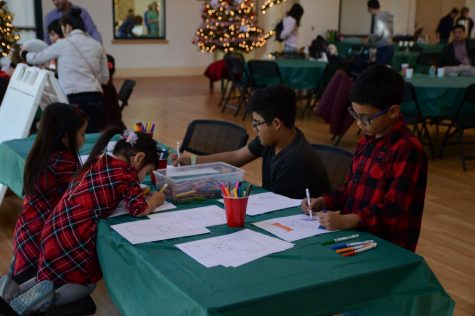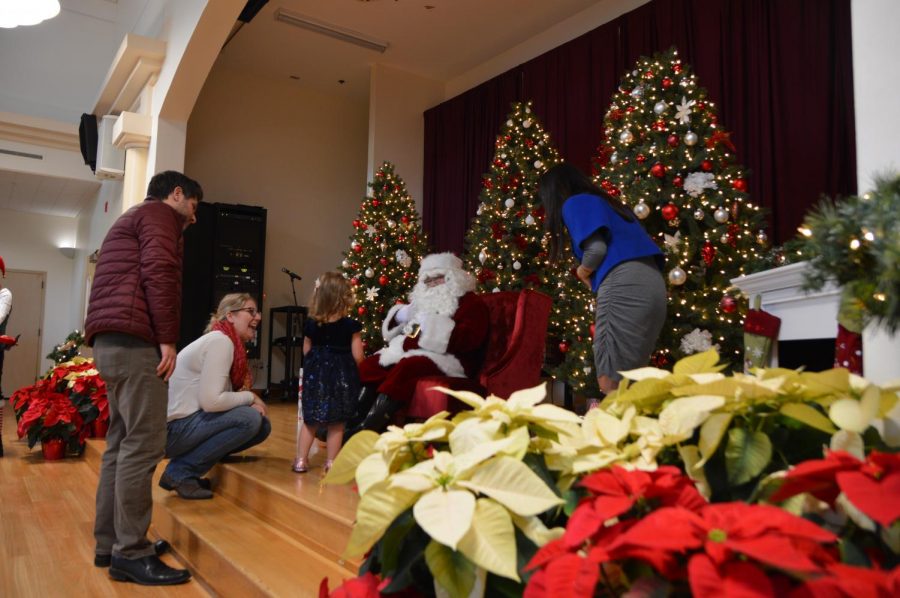Signing Santa: City of Cupertino hosts Christmas event allowing deaf and hard of hearing children to interact with Santa
A child communicates with Santa as ASL interpreter Darlene Rochkind provides additional encouragement.
January 11, 2020
Christmas trees sparkling with red, green and blue lights surround the Quinlan Community Center’s Cupertino Room. Onstage, red and gold poinsettias adorn a cozy living-room scene: three large christmas trees, decorated with ornaments, next to a fireplace lined with green and red stockings. In the center of it all is Santa Claus himself, dressed in a red fur jacket and pants with a matching hat. Children line up to take pictures with him and share their holiday wishes. It resembles a typical meet-and-greet with Santa except for one major difference: there’s no talking involved. The exchanges between the children and Santa take place with no words. On Dec. 14, the City of Cupertino hosted Signing Santa, an event designed for deaf and hard-of-hearing (DHH) children to interact with a Santa fully fluent in American Sign Language (ASL).
One parent, David Zimring, learned about the Signing Santa event after actively searching for similar events for his deaf son, Caleb. The Signing Santa event provided David’s family with an opportunity to connect with other members of the DHH community during the holiday season. Even though Caleb has cochlear implants, an electronic surgical implant which provides a sense of sound, David has encouraged his family to learn sign language and tries to keep active in the deaf community.
“After [Caleb] was diagnosed and we understood that he was deaf, we already knew that sign language was the language for deaf,” David said. “So I said, ‘Even if he gets implants … and even if he talks, we always know that he will be deaf his whole life. So he needs to learn sign, [and] we need to learn sign [language].’”

A helper dressed up as an elf provides children with candy canes after they have interacted with Santa.
However, not all parents of DHH children choose to learn or teach their kids ASL and, instead, prefer to teach them communication through lip reading or forms of spoken languages. According to the National Institute on Deafness and Other Communication Disorders (NIDCD), roughly two or three children out of every thousand are born with hearing loss, and over 90% of these children are born to parents with regular hearing. Many parents are forced to decide whether to adopt ASL as a primary language for their children or to try to use a spoken language instead. David made his decision after considering the importance of different forms of communication for Caleb.
“Even if your child or someone you know has cochlear implants and does prefer to talk — [Caleb]’s a talker, no question — it’s always important to remember they will always be deaf,” David said. “And so, learning sign [language] is essential.”
Caleb currently attends California School For the Deaf, a school for DHH children located in Fremont, Calif. Although the school often hosts events catered to its community, David finds it rare for mainstream community events to be designed for DHH, especially a holiday-themed one like Signing Santa. One of the challenges David faces is finding other parents and children for Caleb to communicate in ASL with, which this event allowed him to do.

Children draw and create ornament crafts after interacting with Santa.
Signing Santa was organized by City of Cupertino Recreation Coordinator Molly James. James gained inspiration for the event when she was attending a National Recreation and Parks Association (NRPA) sponsored school for event management. James discovered a similar Signing Santa event in Lacey, Wash. which she thought would be relatively easy to incorporate with the rest of Cupertino’s holiday events. After deciding to host the event, James found the process of organizing the event fairly smooth.
“Coincidentally, our Santa works in our finance department,” James said. “So I reached out to him to see if he had contacts for me. And he wrote back and said he would be happy to help us. He also [had] a wealth of information and was able to give us different Facebook groups to advertise through and other organizations that might be interested.”
ASL interpreters Naomi Morineau and Darlene Rochkind helped to provide sign language interpretation during the event, assisting Santa and communicating with children over the event’s duration. Morineau learned about the event from her agency, Purple Communications. Morineau and Rochkind grew up learning sign language with deaf parent(s) and are now fluent in English and ASL.
Morineau views the size of the deaf community around the Bay Area as both large and small. Because of its connection to San Francisco, a city Morineau deems a metropolis, the Bay Area has a lot more accessibility than areas that are more rural. However, the city of Cupertino is a smaller city and doesn’t have schools tailored to teaching DHH students, so Morineau believes the DHH community is not as prevalent in the city. Rochkind finds that this adds to the value of the Signing Santa event.
“That’s what’s really cool,” Rochkind said. “[The event]’s in Cupertino, and … I would have thought that other cities that have more of a deaf presence like Fremont, that they would have something like this.”
In the future, James hopes to continue the Signing Santa event while also planning more events aimed at communities using ASL. This year, James felt that the event was relatively easy to execute since many decorations had already been set up for other holiday events held by the city. James hopes to attract even more participants in the future.
“I think once you do an event one time, it’s much easier to get people,” James said. “So I anticipate we’ll have larger crowds next year, now that we sort of have a network of people who know about it and are interested and can help us spread that net.”
Morineau was pleased with the turnout of Signing Santa, and she hopes the community will become more aware of the DHH community.
“I know a lot of children would like to see Santa in sign [language] and not have an interpreter,” Morineau said. “I have not seen a signing Santa ever in my 40 years on this planet, so this is wonderful. I don’t have any kids of my own but I can’t imagine a child not wanting to speak directly to Santa.”


















